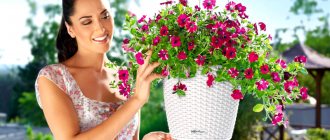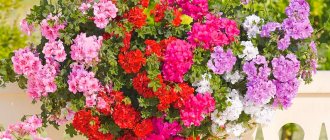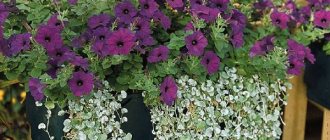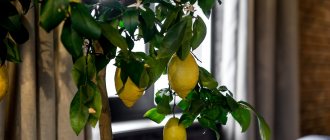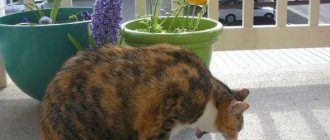Ampel plants, or ampels (derived from the German word die Ampel - a hanging flower vase) are ornamental crops grown in hanging pots and cache-pots. It is very easy to understand what ampelous means: such flowers have long, flexible stems that need support to grow in a given direction or go down in the form of a waterfall. In semi-ampeloid flowers, the shoots first stretch upward, forming a massive cap, and then begin to bend and hang down.
Features and advantages of hanging plants
A characteristic feature of the plants is a flexible stem that needs support: the flower curls upward along special nets or stands. If there is no support for the shoots, the pots are installed or suspended at the required height.
Flower wall made of ampelous Viola
Some plants are used as a ground cover crop, planted in open ground. However, this method does not reveal their true beauty.
The use of this type of plant is not limited. They are grown:
- as home interior decoration or on balconies;
- to create coziness in summer cottages by hanging flower pots near verandas and gazebos;
- in greenhouses, botanical gardens;
- for improvement of public places (parks, squares, train stations).
Advantages of growing hanging plants:
- Mobility. The issue of changing the location of the flower is resolved instantly: just move the pot to the right place.
- A variety of varieties to create picturesque compositions.
- Space saving. Flowers do not need to look for free space on the windowsill or shelf. When suspended, they will take up space, like a wall painting.
- Easy care in the form of regular watering and good lighting.
- Rapid growth and flowering throughout the warm season.
- Growing in urban environments. The lack of a summer cottage is not a reason to give up gardening: plants can be grown in pots on the balcony, giving it an unusual look.
How to make a composition of ampelous plants
From hanging flowers you can grow a magnificent composition and even a real masterpiece of landscape design. Creeping plants will cover the soil with a “carpet” and create a background for the composition. Common loosestrife, dichondra and small periwinkle are suitable for this purpose. You can grow a dense “forest” from succulents.
Perennial gladioli flowers - description
Larger multi-rosette flowers should be placed in the center of the composition. They are used to grow shapes: a heart, a star, an animal’s face, etc. You can choose one of the brightest flowers and make it the center.
Falling plants must be grown at a certain height: they must rise above the rest of the composition. Flowerpots with high legs can be placed in the center or on the sides. Hanging flowerpots will decorate the walls. Climbing and climbing plants are ideal for decorating arches, walls, roofs and other vertical surfaces. They can even be woven into outbuildings.
The composition can be supplemented with foreign objects, for example, old baskets, boots and any other unnecessary things. You need to show your imagination: experiment with shapes, combine different shades, add unexpected details, place flower pots on different tiers.
Additional Information! Arches and walls can be decorated with climbing roses. But these flowers are very whimsical.
Hanging pots and vases
Placement of hanging gardens: garden design style and color concept
Hanging gardens are an original decoration of a summer cottage. They need to be cared for in the same way as a regular flower bed, depending on the needs of the plants. A hanging garden is a flower ensemble consisting of 5 or more plants of different species growing in hanging boxes. To create a hanging garden you will need many trellises and beams located at different heights. All flowers in the composition should receive the same amount of light, moisture and fertilizer. You should not plant light-loving and shade-tolerant flowers next to each other, as well as annuals and perennials.
Hanging Garden
Hanging plants for the garden will add a touch of luxury to even the most inconspicuous area. The hanging composition looks like a light cloud hovering over the garden. It is necessary to care for hanging flowers just as carefully as for ordinary ones.
Coffee capsule Nescafe Dolce Gusto Chocochino, 3 packs of 16 capsules
1305 ₽ More details
Hot chocolate capsules Nescafe Dolce Gusto Chococino, 8 servings
334 ₽ More details
Reinforced film
Types of hanging plants
Among the variety of varieties, three groups of hanging plants are distinguished.
Succulents
Ampelous unpretentious perennial flowers for the garden
These include Rowley's ragwort, sedum, whip-shaped dysocactus, etc. These plants are valued for their hardiness and minimal care. The succulent shoots hanging from the pot are a heavy mass, so the flowerpot must be very stable or firmly fixed.
Important! Succulents love diffused light and humid air. They do not tolerate heat or excessive moisture.
Blooming
Representatives of this variety: fuchsia, aimenes, violet, etc. These are lovers of bright lighting, but not direct sunlight, heat, high humidity and regular watering.
The base of the roof of the house was decorated with flowering hanging plants - fuchsia
Decorative foliage
These include tradescantia, begonia, crested chlorophytum, etc. Shade-loving plants. For the bright color of the leaves they need fertile soil. Watering is carried out only after the soil has completely dried.
Pelargonium
The hanging stems of ampelous pelargonium reach 90 cm. They are covered with smooth dark green leaves and beautiful bright flowers.
Unlike ordinary geranium, this species is more capricious. Flowering will last only if you feed it weekly with complex mineral fertilizer.
Pelargonium is not afraid of direct sunlight, but it can die from waterlogging. Therefore, when planting, one should not forget about drainage.
Be sure to subscribe to our Zen channel, and you will constantly learn something new and interesting.
What plants are suitable for hanging cultivation?
Ampel plants for home and balcony
Colorful, beautifully flowering plants with a large hat or long shoots falling from flowerpots are ideal for hanging cultivation.
Among the succulents, the most popular are:
- Sedum Morgana, or sedum. Growing is possible at home, in the garden. Fleshy cone-shaped leaves form massive lashes. Moisture accumulates inside the shoots, and therefore it tolerates drought well. This thrifty flower is suitable for busy people who are away from home for a long time. It blooms with small reddish flowers.
- Godson Rowley. People call it green pearl for its beady leaves strung on a thread - a thin stem. Flower growers grow ragwort both at home and in the open ground. Its stems reach up to 2 m. It blooms with white flowers, similar to dandelion, but the plant is valued for its foliage.
- Disocactus braided. A cactus with hanging spiny stems, reaching 1.5 m in length and 2 cm in thickness over five years of cultivation. In spring it blooms profusely with large pink tubular buds.
Flowering hanging plants have won the love of gardeners with their variety of colors, abundant flowering and unpretentious care.
- Fuchsia. The ampelous variety has thin stems that form a lush crown cascading down. Unusually shaped buds can have different colors.
- Aimenes. Perennial with a winter dormant period. The leaves are oval, pubescent. The buds are shaped like a funnel with five blades. Abundant and lush flowering with all the colors of the rainbow makes the plant a universal favorite.
- Violet, or viola. The flowers are similar to field pansies, only larger. Planted both in pots and in open ground.
Examples of decorative deciduous ampelous flowers:
- Tradescantia. It is a creeping, creeping shoot with oval leaves densely located on them. The color of the leaves is varied. There are varieties where one side is usually green, the other side is burgundy. Also some have white, pink stripes. Blooms with large white and pink flowers.
- Begonia. A flower with asymmetrical leaves and lush red blooms.
- Chlorophytum crested. The bush has long green leaves 3 cm wide with a white stripe in the middle. Shoots hang from the middle, on which daughter bushes are formed over time, overall representing an original cascade.
Tradescantia, thanks to its unusual colors, has not lost its popularity for a long time.
Blooming for more than one year
Yellow daisies are perennial flowers
Ampelous perennials make life much easier for the gardener, since they do not need to be sown every year. It is enough to provide them with certain wintering conditions. These include:
- Scaevola pleasant overwinters in a humid room at a temperature not exceeding 10 °C;
- dichondra overwinters with additional lighting and rare watering;
- bacopa will not bloom in winter, but if watered moderately, it will overwinter comfortably;
- Campanula equifolia is an ampelous perennial that blooms all summer. Tolerates winter together with indoor plants. Popularly called “bride and groom”;
- perennial lobelia will overwinter if it is covered and not allowed to get too cold;
- geranium can also overwinter in an apartment; with moderate watering and light, it blooms in winter.
Choosing hanging plants for the garden
What are gerbera flowers - what they look like and how they grow
An ampelous flower is a plant that can be used to decorate a veranda, gazebo, or fence. Planted tubs of flowers along the terraces will look good. An inconspicuous wall can be decorated with vines of climbing plants planted in the ground, having previously set the directions with tied ropes.
Interesting! You can use vines to form a metal arch, which will serve as a guiding support for the flower.
You can decorate antique things with hanging flowers, giving them a second chance at life. For the designer there is no question what this means - hanging, he understands that such plants can be used to decorate a broken bicycle, a kettle, a small cart, or a wheel.
Benefits of Plants
What are ampelous plants and ampelous annual flowers?
The mobility of the plant is one of its main advantages. Even during one season, the location of the pot can be changed: to cover some unfinished areas in the garden, to hide areas of construction and repairs during the celebration. Plants do not require special care; they do not need to be weeded or to fight weeds and open ground pests.
For your information! If the plot of land in the garden is small, but you want a flower bed, unpretentious hanging flowers for the garden are an excellent solution.
Flowerbed design option
What varieties of hanging trees are best to plant on the site?
On the plots, ampelous annual plants are most often planted. A short list of the most used ones:
- Petunias. The importance of these cultures is difficult to overestimate. When asked “what are hanging plants,” these are the flowers that come to mind first. Petunias are used to build gorgeous cascades, balls, and decorate vertical surfaces. Her flowers delight until the month of November.
- Lubelia. These hanging annuals love sun and abundant watering.
- Dichondra. Creeping bindweed plants with shoots up to 1.5 m long.
Petunia variety Strawberry with cream ampelous F1
The following are perennials:
- Pelargonium or geranium. It is ideal for busy people because it tolerates drought well.
- Begonia. A fastidious flower, the complete opposite of geranium. Requires careful care and does not tolerate heat.
- Strawberries and strawberries. These crops have a hanging variety, which is popular with experienced gardeners.
Flower vases can be easily moved to another place, thereby updating the appearance of the garden. Using this method of arrangement, you can significantly transform any corner of the site.
Kinds
Ampelous plants for the garden, which can be planted in hanging pots, surprise with their diversity. The most common of them are:
- Petunia is the queen of ampelous flowers. Besides warmth and sun, she doesn’t really need anything else. Although an annual, it is very loved by gardeners;
- ampelous fuchsia is very spectacular, its flowers are small but bright;
- Surfinia is often called petunia; its flowers are similar, but smaller. Shoots can reach up to 1 m;
- Begonia is a shade-tolerant flower that does not tolerate sun and heat. It looks very beautiful in a flower pot, the greenery is at the top of the pot, and the inflorescences are cascading down;
Barrel with petunia
- ampelous geraniums are planted with several bushes of different colors in one pot. Multi-colored hats with long shoots delight the eye all summer;
- nasturtium is bright and colorful. The climbing type is suitable for hanging pots; upright bushes can decorate a flowerpot;
- Dichondra is called a silver waterfall due to the beautiful tint of its green leaves. The plant practically does not bloom, its advantage lies in its beautiful greenery, hanging down one and a half meters;
- lobelia is a bright bush with densely dotted small leaves and flowers. It is often planted only for the season, although it is perennial.
How to grow hanging plants
A simple way is to purchase ready-made flowers in a specialized store. All that remains is to choose a pot, place the plants there and arrange them in the right places on the site.
It is much more difficult to grow a crop from seeds, because it is not known what varieties will be obtained in the end and whether they will be combined with each other. Therefore, the seeds are planted in separate containers. Stronger plants are transplanted to a permanent place according to their preferences for the composition of the soil and its properties.
Determining the required soil is possible using the label on the seed package. The universal substrate for ampels is a combination of soil and peat 1:1.
Important! If there is a possibility of vegetative propagation of this type of plant, then you should not neglect it. It is the simplest and most effective.
Rules of care
Potted plants grown in pots require frequent watering, unlike those planted in the ground. The smaller the container, the more often the flower requires abundant watering. The soil must be equipped with drainage.
Lighting depends on the type of plant: light-loving or preferring to grow in a shaded area.
It is difficult for a plant whose stems hang a considerable distance from the pot to withstand the load. You can help the flower with the help of supports in the form of nets, columns, stretched threads around which the stems will wrap. The main requirements for supports are their stability and invisibility, so as not to distract attention from the object being tied up.
The plant is supported by a mesh
Pruning of ampels is carried out for rejuvenating, sanitary and formative purposes. Slow-growing plants should not be pruned. Dry shoots and wilted flowers are removed from fast specimens. Forming is resorted to in order to give the flower the necessary shape.
How to make a composition of ampelous plants
To give the garden brightness and uniqueness, ampelous plants are planted in combination with other species. Flowering species are combined with each other, as well as with decorative foliage plants. For example, bright petunia looks great with verbena, red geranium with white petunia, fuchsia with lobelia.
Unusual landscape composition
Plants for the balcony
Decorating a balcony or loggia in an apartment with flower pots is a great idea for creating a cozy place to relax from the bustle of the city. Plants are brought to the balcony in May, when the danger of frost has passed, and watered daily.
Important! Balcony boxes must be well secured or placed securely.
Which hanging flowers to choose for flowerpots
Indoor plant species are used for the interior. Before choosing them, you need to consider the location of the balcony:
- South and west sides. Characterized by good lighting and constant exposure to dry air. Preference is given to verbena and milkweed. All flowering plant species will also fit perfectly, for example, petunia, pelagonia, surfinia, multifloral jasmine.
- North side. A shady loggia is suitable for shade-loving decorative foliage plants, such as begonia, impatience, and fern.
- East side. There is a compromise between light and shadow, which means both sun-loving and shade-loving plants are suitable for growing.
Decorating a balcony with hanging flowers
Pots with begonia, lubelia, and ampelous verbena will withstand the excessively windy side, which means a certain endurance of these species.
Important! Plants classified as succulents are not allowed on the balcony. You should also not plant flowers with opposite preferences in the same box, because... caring for them is very different.
Plants for hanging pots
Indoor fuchsia and ampelous begonia are taken out of the apartment and hung on the balcony in the summer, maintaining the same care for them. Garden long-flowering annuals also do well outdoors: petunia, verbena, snapdragon, viola, nasturtium, scaevola.
A hanging vase is convenient because it can be moved from place to place, changing the look of the balcony. For single plantings in hanging pots or flowerpots, bacopa, diascia, and bidens are suitable.
Ampelous flowers are very convenient for growing in the garden or on the balcony. The main thing is to choose the right variety and provide it with the right conditions.
Decorate the interior
Ampelous plants have advantages over ordinary flowerpots: lovers of indoor flowers usually do not have enough space on the windowsills to place all their favorites. Hanging plants are most often placed in hanging baskets, so they practically do not need space indoors. In addition, with this arrangement it is easy to care for plants and decorate the interior with them. Ornamental plants that have long hanging, creeping or climbing shoots are called hanging plants. Most often they are kept in hanging and wall vases, baskets and boxes. Used for landscaping windows and doors, niches and arches.
Epipremnum
© blumenbiene
When filling the window space, care should be taken that the plants do not interfere with the penetration of sunlight. To decorate niches and arches, you can choose plants with more green mass. Hanging plants can also be placed on shelves and stands. They are suitable for decorating balconies, verandas, terraces, and shop windows. This group of plants gets its name from the German word “ampel” - hanging flower vase. However, Ampel was also the name of a beautiful young man who angered the god Zeus, and for this he was turned into a hanging vine.
Aeschynanthus
© cliff1066™
But the branches of hanging plants do not have to hang down. They can, on the contrary, be directed upward. To do this, use stands, gratings, ladders, sticks, cords, trellises. Such plants are used mainly for vertical gardening and dividing the room into zones.
Hanging zebrina, duchenea, tradescantia, sedum, chlorophytum, saxifrage, episcia, begonia, phytonia, zygocactus, pelargonium, hoya, fuchsia, cissus, ivy, sedum, asparagus, and some types of ferns are used as hanging plants. Nephrolepis tall with long leaves is especially attractive. When placing hanging plants, remember the specifics of caring for them. An important condition is that the hanging basket is securely attached to the ceiling or walls. The flowerpot for hanging should be light, preferably plastic, and should not touch the wall, otherwise the crown will form unevenly.
Vertical gardening (Green Wall)
© mannewaar
Sedums, ferns, asparagus, chlorophytums, ceropegia, tradescantia and some other plants can be placed outdoors for the summer. To diversify the interior, you can plant not one, but several plants in one flowerpot. The main thing is that they have enough space.
Morgan's sedum (Burro's tail)
© HundaHunda
It is more convenient to water hanging plants using a watering can with a long spout. If you are using a planter for a hanging basket, drain off any excess water after watering. Canopy plants need to be sprayed, because the air above is drier than on the windowsill. It is advisable to immerse them in water once a week. They are replanted annually in spring into fresh soil. To ensure leaves grow evenly, plants need to be rotated regularly so they receive light from all sides.
Tradescantia is a shade-tolerant plant, it can be placed on northern windows. Propagated by easily rooted cuttings. The lower part of the stems of old plants is often exposed, so Tradescantia needs to be rejuvenated from time to time by rooting cuttings. There are many varieties of Tradescantia, so choose according to your taste.
Tradescantia
Saxifraga is planted in small hanging baskets. She is afraid of soil acidification. Keep it in a bright, cool window.
Asparagus are very unpretentious plants. Their openwork leaves will decorate any window. True, they crumble, so the leaves should be removed regularly. In summer, asparagus trees are shaded from direct sunlight.
Chlorophytum is distinguished by beautiful openwork rosettes that look like green garlands. The bushes grow quickly, young plants take root well. This plant purifies the air very well.
Ivy is also a very popular houseplant that is easy to propagate. It has very beautiful leathery leaves of an original shape. The varieties with a white border on the leaves are especially attractive.
